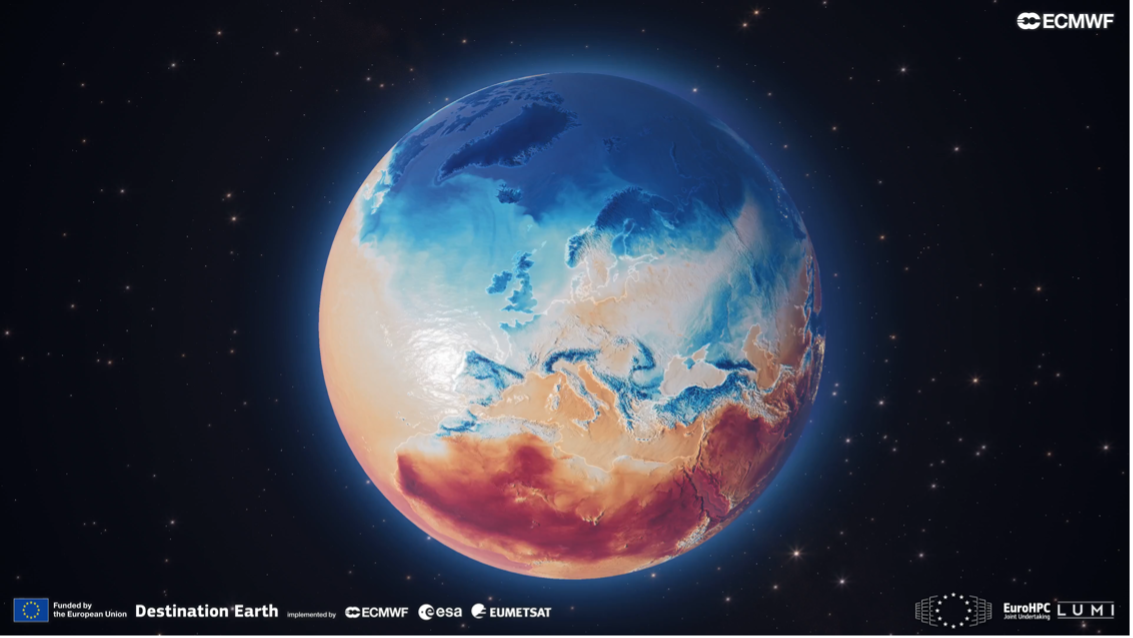Destination Earth’s Climate Change Adaption Digital Twin: operationalising multi-decadal climate projections

In less than two years, the Climate Change Adaptation Digital Twin of DestinE has made remarkable progress. The Climate DT is implemented by a strong partnership led by CSC IT Center for Science, involving 13 leading climate institutions, supercomputing centres, national meteorological services, academia, and industrial partners, through a contract procured by ECMWFEuropean Centre for Medium-Range Weather Forecasts More and funded by the European Commission in the framework of DestinE. The Climate DT teams have succeeded in building the key elements of the system, deploying it on the EuroHPC LUMIOne of the EuroHPC pre-exascale supercomputers, hosted and o More supercomputer, demonstrating its key innovative features at scale, and performing the first-ever global multi-decadal climate change projections at 5 km resolution ahead of the DestinE launch event on 10 June at LUMI Data Center.
The Climate DT represents the first attempt to operationalise climate projections. While the previous multi-decadal climate projections were often research-focused efforts performed only every 7 to 10 years, the Climate DT will produce operational, quality-assured simulations at least once every year. At the same time, the Climate DT is setting a unique capability to produce bespoke, cutting-edge numerical simulations addressing ‘what-if’ questions related to the impact of certain scenarios or policy decisions on the evolution of our planet.
Additionally, the Climate DT will provide global, kilometre-scale storylines of recent extreme weather events under different climate scenarios.

The Climate DT brings added value to the users compared to current climate modelling activities by providing globally consistent data with higher temporal (hourly) and spatial (5 to 10 km) resolution, delivering an updated data set more frequently and considering the needs of the users in terms of the output variables and simulation design.
To ensure it provides information relevant for the sectors most impacted by climate change, the Climate DT has integrated from the beginning five applications for use cases. These include renewable energy, hydrology, hydrometeorology, urban heat, and wildfire risk assessment.
Read more on the features of DestinE Climate Change Adaptation Digital Twin in this in-depth article and on its fast development pace on this in-depth article.
Phase I achievements
During Phase I (2022 – 2024) the Climate DT teams have successfully implemented the end-to-end workflow on Europe’s first pre-exascale supercomputer in Europe, LUMIOne of the EuroHPC pre-exascale supercomputers, hosted and o More, and the three state-of-the-art climate models involved, ICON, IFS-NEMO, and IFS-FESOM, at resolutions ranging between 5 and 10 km for the different components (atmosphere, land, ocean, and sea ice).
The teams involved have also implemented the software and data infrastructure that lay the foundations for the future operational Climate DT system.
The first storyline global simulations of past weather events at kilometre-scales have been produced on the LUMIOne of the EuroHPC pre-exascale supercomputers, hosted and o More supercomputer with IFS-FESOM using resolutions of 9 km for the atmosphere and land and 5 km on average for the ocean and sea ice.
Looking ahead: Phase II objectives
During Phase II of the DestinE initative (2024-2026) the Climate DT teams will focus on further enhancing the capabilities of the system and advancing towards operationalisation.
This includes refining the monitoring, evaluation, and uncertainty quantification frameworks.
Another aim is to integrate advanced artificial intelligence and machine learning techniques. This would allow interaction with the system data for evaluation purposes, and expand the scope of impact sector applications to address emerging challenges.
Read the full article on the development and objectives of the Climate DT on the ECMWFEuropean Centre for Medium-Range Weather Forecasts More DestinE website: The fast development of DestinE’s Climate Change Adaptation Digital Twin